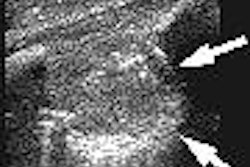Chest discomfort is often the first manifestation of coronary artery disease in both men and women. Unlike men, however, women don't always benefit from traditional cardiac testing methods such as coronary angiography. But rather than subject women to a battery of other exams, what is needed is a better understanding of the clinical manifestations of heart disease in women, according to Canadian researchers.
Dr. Anthony Sanfilippo and colleagues followed 158 women for a mean of 26.2 months. These women had presented with chest pain with no established diagnosis, at least two cardiac risk factors such as diabetes mellitus or smoking, and were able to undergo noninvasive testing.
Sanfilippo is from the department of medicine and cardiology at Queen's University and Kingston General Hospital, both in Kingston, Ontario. His co-authors are from the university's department of community healthy and epidemiology, as well as Belleville General Hospital in Belleville, Ontario.
Fifty-four women underwent electrocardiographic treadmill testing. Stress echocardiography was performed in 57, and dobutamine stress echocardiography in 43. Of these, 15 patients (13 from stress electrocardiography; two from stress echo) had indeterminate results and required dobutamine stress echo (DSE), which offered definitive results.
The results showed that only 2.5% of the women had a hard cardiac event (two cases of myocardial infarction; two cases of unstable angina). The majority of women (81%) experienced chest pain that was unrelated to a cardiac event. The remaining 19% continued to have chest pain during the follow-up period, but experienced no adverse events.
While the positive spin on these results would be that many of these women were not at serious risk for heart attack, the authors suggested assessing them with greater caution.
"An alternative interpretation of the findings is that within about two years ... 19 of 158, or 12%, experience an acceleration of symptoms requiring further attention, unplanned invasive investigation, and in four cases, acute coronary syndrome with evidence of MI in two. This should be viewed as both unacceptable and preventable," they wrote (Journal of Women's Health, April 2005, Vol. 14:3, pp. 240-247).
Stress testing proved to be the most useful, with 24 positive cases, especially in women subsequently demonstrated to have cardiac or continuing symptoms, they stated. With regard to risk factors, only a history of diabetes was significantly associated with a cardiac event.
The authors concluded that in nondiabetic women with chest pain, and at least two other cardiac risk factors, a negative stress test was a safe bet for a benign course. In addition, cardiac chest pain is more likely to be established by cardiac clinical events or coronary disease on angiography.
In a second study using the same patient population, Sanfilippo's group compared dobutamine stress echo to electrocardiographic stress testing (EST) and treadmill echocardiographic stress testing (ExE) for establishing coronary artery disease. They reiterated that all modalities were effective at excluding cardiac chest pain with a negative predictive value of 91.3% for EST, 83.7% for DSE, and 88.4% for ExE.
"Echocardiographic testing modalities are more likely than EST to provide both definitive and accurate results and would, therefore, seem to be the superior primary noninvasive testing modality in this patient population," they concluded (Canadian Journal of Cardiology, April 2005, Vol. 21:5, pp. 405-412).
By Shalmali Pal
AuntMinnie.com staff writer
May 30, 2005
Related Reading
Imaging tackles cardiac 'octopus pot' syndrome, April 19, 2005
Echocardiography bests treadmill test for diagnosis of CAD in women, June 14, 2000
Copyright © 2005 AuntMinnie.com



















